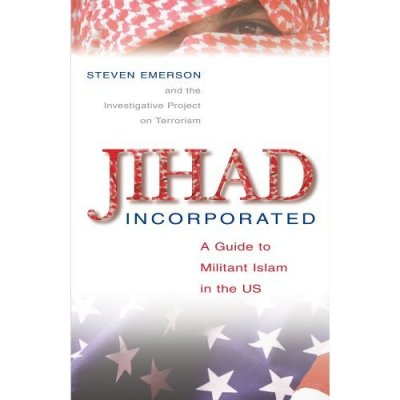
Jihad Incorporated-Steve Emerson’s guide to militant Islam in the U.S.
Frontpage Mag
Frontpage interviewed Steve Emerson, executive director of the Investigative Project on Terrorism, one of the largest archival data centers of militant Islam. He started the organization in 1995 after a film he did, Jihad in America.
He works closely with law enforcement, Congress and the media. His organization’s mission is to investigate and expose the threat of radical Islam. He is the author of the new book, Jihad Incorporated: A Guide to Militant Islam in the U.S., which covers every radical Islamic operation, prosecution and incident on American soil, or against American targets, in the last 10 years.
FP: So what inspired you to write this book?
Emerson: It was really the collaborative product of my research staff. We felt that a reference book was needed in which all Islamic terrorist groups, operations and prosecutions connected to the US could be found in one place. It’s really a history of radical Islam in the US.
FP: How do you go about your work in collecting data on the bad guys?
Emerson: We collect data in numerous ways. From websites, list serves, publications, informants, undercover recordings, government records, court documents, and sources. We have acquired close to 4 million documents and 18,000 hours of audio and video of radical Islamic gatherings, conferences or speeches.
FP: Who are your “consumers”?
Emerson: Well, we really have no traditional “consumers” since we don’t sell our information and we don’t take a penny of government financing. But we do work closely with law enforcement, Congress and the media. Each “consumer” has a different institutional interest. Law enforcement wants to make cases; Congress wants to exercise oversight and disseminate original information; and the media wants news.
FP: Tell us some of the key players in the terrorist network. And which groups are the most influential among the jihadi groups today?
Emerson: Well, today, the terrorist hierarchy has changed considerably from the pre-911 days. Al Qaeda is still the grand-daddy but it obviously lacks the punch and reach it once had. Instead, there are mini-Al-Qaedas that have formed, either in Asia, the Middle East or the West. Jamat Islamiya in southeast Asia has become more of an Al Qaeda surrogate. Hamas, while largely maintaining a hudna, is busily reinforcing and re-invigorating itself with new weapons and explosives for the day that it deems advantageous to attack Israel. Hezbollah, which survived intact in its war with Israel, was actually hurt militarily more than some had estimated. It does however have a worldwide presence.
The threat against individuals or governments deemed to be “enemies of Islam” is growing in its dimensions. The killing of Theo Van Gogh, the recent threats against the Pope, the Danish cartoon controversy all highlighted the growth of threats against high profile targets in the West’s backyard.
FP: Can you talk a bit about the organizations in the Middle East, aside from al Qaeda, that pose a threat to us?
Emerson: Well, I would say that Hezbollah poses the greatest threat to American interests today. They have their own ideological hatred of the United States and they are also effectively controlled by Iran. Islamic Jihad, because of its closeness with Iran, could easily put Americans in its crosshairs.
FP: How entrenched are the jihadists in the US today? Are there different gradations of jihadists?
Emerson: There are essentially two types of jihadists. The hard-core military jihadists who are prepared to carry out terrorist attacks in the United States. They have already been indoctrinated. All they await is a charismatic leader or the external order that gives them a green light. Secondly, there is the far greater number of what I call “cultural jihadists.” The cultural jihadists are not willing to carry out attacks themselves, but rather, they provide the moral support for the military jihadists.
They are the ones that believe that Israel or the US carried out 9-11. In the trial of the would-be NYC Herald Square bomber, an undercover informant for the NYPD recounted an astonishing observation. He said that as he made his rounds among two different mosques, he encountered a virulent hatred for the United States. For example, I can show you a tape of a Hamas rally held in New Jersey where thousands of people in attendance—women, children and men—are all chanting slogans such as “We buy paradise with the blood of the Jews.” Do I think that all of them are terrorists? Of course not. But they are cultural jihadists.
The cultural jihadists provide the environment for the military jihadists.
Beyond the physical threat posed by jihadists, there is the issue of free speech being increasingly curtailed by virtue of radical Islamic groups–masquerading as “civil rights” groups–labeling anyone who criticizes militant Islam as racist or as defaming the Prophet Mohammed. The threat of violence during the Danish cartoon episode was the real reason why 99% of US newspapers refused to republish the cartoons. The flip side of this problem lies in the refusal of mainstream media–with some exceptions–to investigate the backgrounds or report the ulterior agenda of these Islamic “civil rights” groups. That’s a dereliction of journalism 101. Why do they do it? Sometimes they are deceived, other times they are sympathetic to the cause of the group.
FP: Illuminate for us the support system for the jihadists that exists within our own borders.
Emerson: There are different tiers. The largest tier is what I called in the previous question the cultural jihadists. They are not willing to carry out attacks but they provide moral support for such attacks. There is the financial infrastructure. Radical Islamic charities had served as a main conduit for terrorist operations and organizations but Treasury has been quite successful at closing the charities whose financing could be linked to terrorist groups. As a result of this pressure, terrorist groups are resorting increasingly to getting their funding from organized retail theft, in which they traffic in stolen or pirated goods (like baby formula), car theft, counterfeit production or bust-out schemes.
FP: To what extent do mosques provide cover for terrorists?
Emerson: Mosques have tended to serve as save havens and meeting points for Islamic terrorist groups. Of course, we are not referring to all mosques but there are at least 40 episodes of extremists and terrorists being connected to mosques in the past decade.
FP: To what extent do terrorists use the Internet for communication?
Emerson: The virtual jihad has now become a dominant mechanism for terrorist communications among themselves, to the outside world and to gather new recruits.
FP: Numerous Muslim American organizations make lobbying efforts to influence the top echelons of the federal government. How successfully are these and what damage do they do?
Emerson: I don’t blame the Islamic radical groups for lobbying. I blame the recipient institutions for legitimizing them. The FBI, for example, has mandated outreach to Islamic groups. That’s a good thing to do in principle. But unfortunately, the groups designated as deserving of being recognized by the FBI have disproportionately revolved around groups that are tethered to radical agendas, such as CAIR and MPAC. In turn, this crowds out authentic moderates whose voices need to be reaffirmed in the community. And it strengthens the hands of the cultural jihadists who tell their followers not to cooperate with the FBI or law enforcement. That’s precisely the wrong message the government wants to communicate.

I’ve not read this book. it certainly looks interesting and I’d like to thank you for showcasing this in this post. I have already added the web address for IP in my favorites and look forward to it’s official ‘launch’.
In reading the post though I was a little confused by Emerson’s almost apologetic comment that he doesn’t blame the Islamic radical groups for lobbying. “Radical”, by nature invites blame and shoudn’t be given a pass at any level, especially in light of that group’s stated goals. I was also surprised by his comment that “there are at least 40 episodes of extremists and terrorists being connected to mosques in the last decade”. This figure seems woefully low for an organization that is promoting itself as being a comprehensive clearing house of information on jihadists. I would think the Al-Farouq mosque in Brooklyn could be connected to 40 ‘episodes’ alone in the last decade.
Still, it would seem that this will be an interesting resource of obscure information that the MSM typically ignores.
Billy
Billy I have noticed that some writers get apologetic about things they are going to say or say like Emerson has done. I agree with you so much about that.
I wonder if they get apologetic as a way of protection. Not sure, it is just a guess of course. It disappoints me so I guess that is why I am trying to understand why a person would do that.
Robert Spencer on the other hand,has had death threats but he never gets apologetic about the things he says.
I am glad Emerson writes what he does but I do so wish any kind of apology would be left out.
The enemy is what it is, we did not make them be what they are. It truly is a death cult and needs to be told that it is far and wide and no excuses for them at all. imo
Thank you Billy for your input on this.